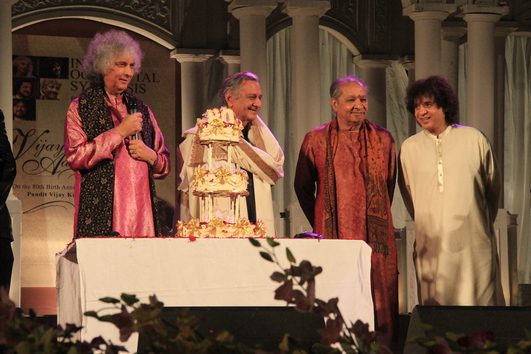Date: November 21, 2014
Venue: Chhandayan Center (NY)
Review by Dawoud Kringle
On Saturday, November 21st a pre-release showing of the documentary Raga Revelry was presented in public for the first time at Chhandayan Center. Directed by Mahesh Nair, and produced by Shreedevi Thacker, the film easily succeeded in the herculean task of taking the music and tradition of Indian Raga, and presenting it in a two-hour documentary; like distilling the essence of an enormous garden into a vial of perfume.
The film opens with Vijay Kichlu standing alone on a stage. He begins sharing an anecdote of when he first heard his future Ustad sang. He spoke about how embarrassed he was that the music made him cry. Everyone else did, too. Another story: another concert with his Ustad singing, and being paralyzed. He wanted to know how this music caused such effects.
The film features interviews with a variety of musicians, including Rashid Khan, Girija Devi, Shiv Kumar Sharma, Zakir Hussain, Ajoy Chakraborty, Ulhas Kashalkar, Mashkoor Ali Khan, Samir Chatterjee, Ravi Mathur and Guy Beck. There were also very interesting and informative demonstrations of the elements of raga by Subhra Guha and Tanmoy Bose. They presented this in a manner that the westerner unfamiliar with Indian music would find easily accessible. Some presentation of the difference between western and Indian classical music is offered. The explanations are clear and precise; easily understandable for the intelligent beginner. Apart from the “nuts and bolts”, the idea of improvisation; i.e. the responsibility of instantly designing the architecture of a raga, was heavily emphasized. Some very interesting and even entertaining demonstrations of this mastery were offered.
There were also offerings of performances by Tejendra Narayan Majumdar, Kushal Das, and Subhankar Bannerjee. One segment presented a performance by singer Ustad Abdul Rashid Khan. As of this writing, he is 110 years young; yet it’s clear that despite his advanced years and physical fragility, he is still in his musical prime.
One very important point that was brought up was that in the performance of a raga, the listener holds as important a position as the performer. This requires notable sensitivity on the part of the listener, even if one may not be familiar with the details of the music. It is not passive background music. One must immerse oneself in the listening experience.
The main focal point of the discourse each musician shared is the transcendent essence of Indian classical music. The history is touched upon (which goes back over 5000 years). It is inescapable that Indian music is an entirely non-sectarian spiritual and meditative art. If the music is not transformational, it is mere empty entertainment.
The film also touched on Kichlu’s establishment of the Sangeet Research Institute wherein the “Gurukal” tradition is practiced. A community of ustads were brought there and offered a permanent home. The students would stay for extended periods of time. They would be totally immersed in their teaching and training. There is no curriculum, no degrees or grades, no restrictions on teaching methods.
The film offers a fascinating look at the history of the music and the modern community of musicians who are keeping this music alive. This finely crafted documentary has a great deal to offer both the novice and the expert.
The main message that runs through the complex, yet always interesting knowledge presented throughout is that the most important thing in raga – indeed, in all music – is “rasa.” Rasa is the emotional content / psychoactive properties of music. Technical virtuosity is not enough. Without rasa, music, any music, is worthless.




